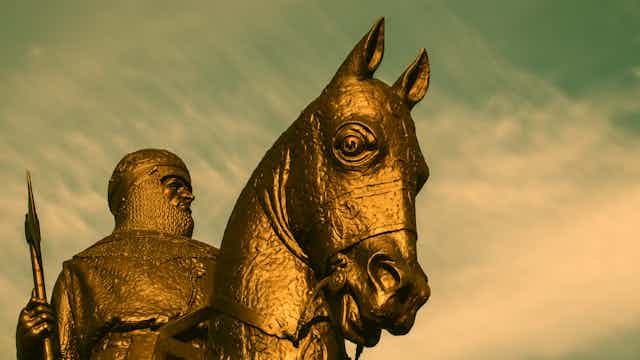Second only to COVID-19 recovery, the continued unity of the United Kingdom is the key political issue across the British Isles. Debates about independence have dominated Scottish politics for the past decade, while in Wales, polling suggests there is increasing support for Welsh independence. In Northern Ireland, meanwhile, many believe the country will join the Republic of Ireland within the next 25 years.
A recent episode of BBC One’s The Big Questions asked “is feeling British over?” and discussed how a feeling of Britishness differs from the respective nationalities that make up the United Kingdom. Whether or not there is any meaningful prospect of any part of the UK breaking away, it is difficult to escape the conclusion that feelings of a distinct Britishness are increasingly rare.
One way in which feelings of identity manifest themselves is in a sense of ownership of a shared past. A shared British past is normally discussed with reference to events from the 18th century onwards after the Anglo-Scottish union of 1707. Proponents of this shared past are likely to point to famous military successes such as Trafalgar, Waterloo or the Battle of Britain.
Battles before the creation of political unions are trickier to celebrate as unifying British events, because ultimately some of the constituent parts of Britain suffered a heavy defeat. Yet, in medieval Britain’s two most famous battles, we see the geography of sharing a small island meant that what happened in one part of the British Isles affected the others. The ramifications of both battles show how the various constituent parts of the British Isles were inextricably linked for centuries before the existence of formal political unions.
Battle of Hastings
The Battle of Hastings, when an army led by William, duke of Normandy, defeated King Harold’s English army, is probably the most famous battle to have taken place on English soil. As a result of this victory, the language and culture of England’s ruling elite became Norman French, which had wider geopolitical effects across the British Isles. Historians have long recognised that the Norman conquest witnessed a change in attitudes towards the “Celtic fringe”. The English began viewing themselves as “civilised” compared to the “barbaric” Scots, Welsh and Irish.
Nobles on the Anglo-Welsh border were given royal approval to expand into Wales, though not necessarily for an official conquest. Instead, those nobles were permitted to continue expanding their influence in neighbouring states. This was part of a wider European trend of Norman conquest and expansion. For those who came with William in 1066, Wales was an area ripe for expanding into.

In Scotland, the situation was different. There was no military invasion. Instead there was a process whereby Scotland adapted to wider social and political trends happening in western Europe, including England. During David I’s reign (1124-1153) in particular, many families of Norman origins, including the Bruce and Stewart families – who later became kings – came into Scotland. The precise extent of the influence is a matter for historical debate, but it is difficult to argue that changes south of the border had no effect on Scotland.
The Battle of Hastings is often seen as a landmark moment in English history, but it was not simply an important event for England. It brought in a different ruling elite in the most populous state within the island of Britain that had different views of England’s neighbours. More importantly, it brought in an expansionist aristocracy. It showed that political change in England could have clear effects on Wales and Scotland.
Battle of Bannockburn
The victory of a much smaller Scottish infantry army led by Robert I (the Bruce) over a much larger English cavalry army in 1314 helps us to understand the ways in which the histories of the British Isles were interlinked. This battle was mythologised by future generations of writers as a rallying point for Scottish statehood.
But it did more than simply allow a smaller state to fight off an invasion launched by a richer and more powerful neighbour. It brought the Scots’ own expansionist agenda to the fore. Victory gave Robert I the confidence, and clout, to launch an invasion of Ireland. English rule there had been in decline for several decades and it was hoped that this would help open another front in the war with England.
Robert’s brother, Edward Bruce, led the invasion and had himself made king of Ireland. Although it ultimately failed, with Edward Bruce being killed in 1318, the invasion was also an attempt to expand the power of the Bruce family across the whole of the British Isles.

Bannockburn was also important in English politics. Four English earls, including the king’s cousin, Thomas, earl of Lancaster, refused to serve in Edward II’s army. Tensions between the king and his barons (particularly Thomas of Lancaster) had existed for several years. In 1311, a set of rules for governing was imposed on Edward and his favourite, Piers Gaveston, was executed by leading earls in 1312.
Eventually civil war broke out twice in the 1320s, the first ending with Thomas of Lancaster’s execution in 1322, the second ending with Edward II’s own deposition in 1327 and murder a few months later. Bannockburn was won by Scottish strength as much as English failures, but for Edward II it further exposed the weakness of his rule and exacerbated existing tensions.
These events are not necessarily good rallying points for a shared sense of Britishness, because they both caused further conflict within the British Isles. However, they show the inherent interconnectedness of the component parts of the British Isles. What happened in one part of the archipelago had the potential to influence events in neighbouring states, regardless anyone’s ideal political structures.

